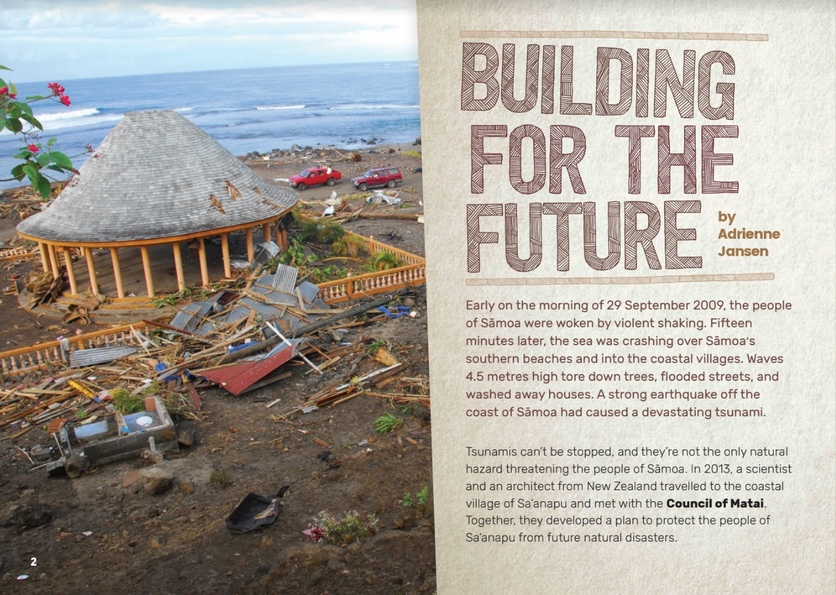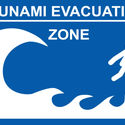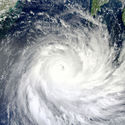Science and partnership with a Sāmoan village looks at the wicked problem of future proofing for natural disasters and how science offers responses to help people. It is a ready-to-use cross-curricular teaching resource. It uses the Ministry of Education’s 2017 Connected article Building for the future by Adrienne Jansen.
The Connected article is accompanied by an audio narration, which may be useful for some readers.
Curriculum information
‘Building for the future’ is a non-fiction article suitable for students working at NZC level 3 and above. The article and accompanying activities support learning in multiple curriculum areas.
Literacy:
- Use personal experience and knowledge to make meaning from the text.
- Make connections by thinking about underlying ideas in the text.
- Make and support inferences from texts with increasing independence, thinking about different perspectives.
Numeracy:
- Develop a timeline that is proportional to the time between dates.
Social sciences – social studies:
- How access to resources impacts on decisions for groups of people.
Science:
- Earthquakes and tsunamis are part of Earth systems.
- One effect of climate change is rising sea levels.
Science – Nature of Science:
- Scientists work in collaboration with others to develop responses to challenges.
- Students have the opportunity to appreciate different perspectives on this issue and to explore responses.
Ecology:
- How can people adapt and respond to the changing environmental conditions?
Customising the resources
The worksheet Science and partnership with a Sāmoan village – learning activities is available in a Word file here and also in the link at the bottom of the page.
Feel free to edit the Word document to meet the needs of your programme and your learners.
A reminder – the journal article is accompanied by teacher support material (TSM). It provides instructional strategies, highlights key science and technology ideas and has activity ideas.
Follow-up for teachers
Tsunamis are a rich resource for teaching, and students enjoy the drama of them. The article Building for the future could provide a launch into finding out about tsunamis. Alongside this is the opportunity to share and discuss tsunami safety practices.
- There is another Connected article, The Tsunami that washed time away, that looks into tsunami effects in New Zealand.
- If your students are curious to understand more about tsunamis and the increasing height of the wave in shallow water, check out this diagram.
- Other connections to tsunamis include waves, storm surges and shoaling. Information on this and some fun student activities can be found here.
- This video is a very informative cartoon from TED-Ed.
- This video has good links to science and also has a nice graphic showing the impact of the tsunami across the oceans of the world (USGS video – 3.08).
- Scientists are looking at protecting our coasts through modelling tsunamis.
Related content
Learn more about the impacts of climate change by exploring the climate change topic.
The 2017 Connected article Rising seas describes how scientists investigate what is happening with sea levels and use evidence to suggest how we might adapt to the changes.
The 2011 Connected article More than a box can help with learning about structures and building.
Weather and climate – the article Extreme weather explores the difference – and a number of resources look at weather forecasting and weather concepts and activities including the water cycle.
Our interactive planning pathways and teacher PLD on climate change resources and tackling planning provide excellent support for teachers wanting to use this wicked problem to promote science learning in their classroom.
More information about how scientists work with models can be found in the article Scientific modelling.
Useful links
Before it is lost is a selection of essays published in the Guardian looking at the impact of the climate crisis threatening the survival of Pacific islands.
The Connected journals can be ordered from the Down the Back of the Chair website. Access to these resources is restricted to Ministry-approved education providers. To find out if you are eligible for a login or if you have forgotten your login details, contact their customer services team on 0800 660 662 or email orders@thechair.education.govt.nz.
Acknowledgement
The Connected series is published annually by the Ministry of Education, New Zealand.





